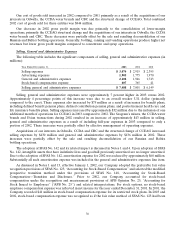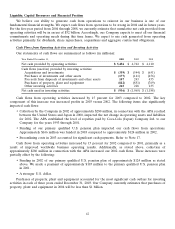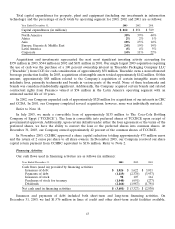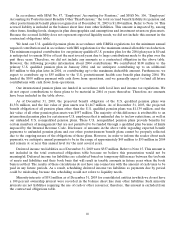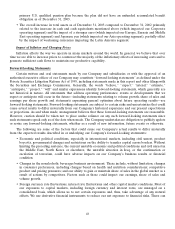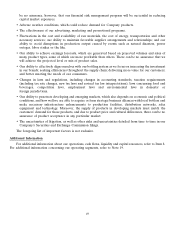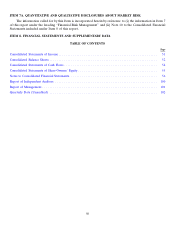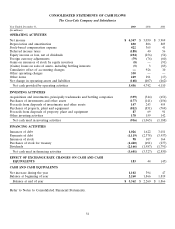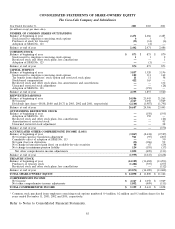Coca Cola 2003 Annual Report Download - page 49
Download and view the complete annual report
Please find page 49 of the 2003 Coca Cola annual report below. You can navigate through the pages in the report by either clicking on the pages listed below, or by using the keyword search tool below to find specific information within the annual report.In accordance with SFAS No. 87, ‘‘Employers’ Accounting for Pensions,’’ and SFAS No. 106, ‘‘Employers’
Accounting for Postretirement Benefits Other Than Pensions,’’ the total accrued benefit liability for pension and
other postretirement benefit plans recognized as of December 31, 2003 is $1,084 million. Refer to Note 14. This
accrued liability is included in the balance sheet line item other liabilities. This amount is impacted by, among
other items, funding levels, changes in plan demographics and assumptions and investment return on plan assets.
Because the accrued liability does not represent expected liquidity needs, we did not include this amount in the
contractual obligations table.
We fund our U.S. qualified pension plans in accordance with ERISA regulations for the minimum annual
required contribution and in accordance with IRS regulations for the maximum annual allowable tax deduction.
The minimum required contribution for our primary qualified U.S. pension plan for the 2004 plan year is $0 and
is anticipated to remain $0 for at least the next several years due to large contributions made to the plan over the
past three years. Therefore, we did not include any amounts as a contractual obligation in the above table.
However, the following provides information about 2004 contributions. We contributed $100 million to the
primary U.S. qualified pension plan in January 2004, and we anticipate contributing up to an additional
$65 million to this plan later in 2004, or contributing up to the maximum deductible amount. Furthermore, we
expect to contribute up to $55 million to the U.S. postretirement health care benefit plan during 2004. We
funded the $100 million payment with cash flows from operations, and we generally expect to fund all future
contributions with cash flows from operations.
Our international pension plans are funded in accordance with local laws and income tax regulations. We
do not expect contributions to these plans to be material in 2004 or years thereafter. Therefore, no amounts
have been included in the table above.
As of December 31, 2003, the projected benefit obligation of the U.S. qualified pension plans was
$1,356 million, and the fair value of plan assets was $1,467 million. As of December 31, 2003, the projected
benefit obligation of all pension plans other than the U.S. qualified pension plans was $1,139 million, and the
fair value of all other pension plan assets was $557 million. The majority of this difference is attributable to an
international pension plan for certain non-U.S. employees that is unfunded due to tax law restrictions, as well as
our unfunded U.S. nonqualified pension plans. These U.S. nonqualified pension plans provide benefits for
certain members of management that are not permitted to be funded through a qualified plan because of limits
imposed by the Internal Revenue Code. Disclosure of amounts in the above table regarding expected benefit
payments to unfunded pension plans and our other postretirement benefit plans cannot be properly reflected
due to the ongoing nature of the obligations of these plans. However, in order to inform the reader about such
payments, we anticipate annual payments to be in the range of approximately $45 million to $55 million in 2004
and remain at or near this annual level for the next several years.
Deferred income tax liabilities as of December 31, 2003 were $337 million. Refer to Note 15. This amount is
not included in the total contractual obligations table because we believe this presentation would not be
meaningful. Deferred income tax liabilities are calculated based on temporary differences between the tax basis
of assets and liabilities and their book basis that will result in taxable amounts in future years when the book
basis is settled. The results of these calculations do not have any connection with the amount of cash taxes to be
paid in any future periods. As a result, scheduling deferred income tax liabilities as payments due by period
could be misleading because this scheduling would not relate to liquidity needs.
Minority interests of $191 million as of December 31, 2003 for consolidated entities in which we do not have
a 100 percent ownership interest were recorded in the balance sheet line item other liabilities. Such minority
interests are not liabilities requiring the use of cash or other resources; therefore, this amount is excluded from
the contractual obligations table.
46


